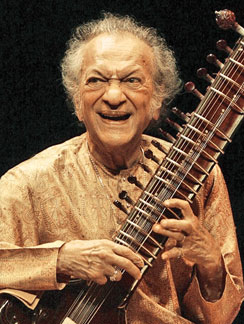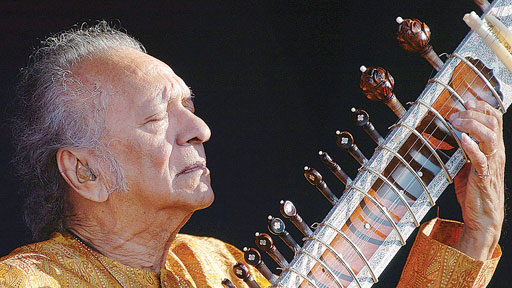|
Pundit Ravi Shankar:
An artiste who reached divine heights of music
By Prof. Kolitha Dissanayake
Pundit Ravi Shankar was a great personality in the Hindustani
tradition of music. He was a musician who had reached divine heights of
music. He was an artiste who could easily define and embody the term
‘Ghandarva’ (a great musician). Above all, he was a great human being.
|

Pundit Ravi Shankar |
The objective of this article is to explore how important the role
played by Ravi Shankar in the field of music and in the field of
research on music. It is relevant, at least, briefly to look at the
North Indian classical music or Hindustani music tradition and its
myriad of applications. Through this introduction, one can identify Ravi
Shankar’s place in it.
Primarily, Hindustani music is divided into two broader segments;
Marga and Deshi. The Marga music is for the Gods and therefore, divine
while Deshi is the music for the masses. When deeply exploring the
salient characteristics of Hindustani music such as Bhava, Rasa, Arta
and Dyana, it is obvious that divine elements have also been imbedded in
Deshi music which is meant for the masses.
When a musician who masters the tradition, that musician is
invariably reach the divine status in music. God dwells in the intricate
notes of his or her and the each and every note in the Hindustani
tradition is assigned to divinity.
Accordingly, the seven notes in the Hindustani tradition; Sa, Re, Ga,
Ma, Pa, Dha, Ni, are respectively assigned to Agni, Bhrahma, Sarasvati,
Maha Deva, Lakshmi Pathi, Ganesh and Surya.
Considering the Hindu cultural life, this notion cannot be simply
rejected as a myth. The argument is justified by the mystic power of
each and every note. The one who rightly manipulates the tonal motifs of
a note may meet the God. Then, such as a musician possess the divine
diction of the music. The divine path is opened before him or her.
Pandit Ravi Shankar manipulates every note, miraculously, having
mastered the divine properties of them. One may ask ‘aren’t the Gods who
play such music?, Isn’t it the divine path in music?. This great
musician had achieved the divine heights in the Deshi music.
Mental training
Ravi Shankar obtained his Sadhana (physical and mental training of a
tradition or School) from Ustad Allauddin Khan. Sadhana is practised
within a tradition of music instilling not only the academic discipline
but also the personal discipline in the practitioner. One who learned
music in such a tradition of music would demonstrate certain salient
characteristics; expressing the expressive value and conceptual value is
one such characteristic.
 One can see how realistically Ravi Shankar applied the conceptual and
expressive value manifested through notes, rhythms and beats in his
applications. The Sadhana would sum up the vast knowledge of music he
gathered over 92 years. Vision build over the years is not only
beneficial to a country but also to the entire humanity. Ravi Shankar
was a musician who had developed such a right vision. One can see how realistically Ravi Shankar applied the conceptual and
expressive value manifested through notes, rhythms and beats in his
applications. The Sadhana would sum up the vast knowledge of music he
gathered over 92 years. Vision build over the years is not only
beneficial to a country but also to the entire humanity. Ravi Shankar
was a musician who had developed such a right vision.
According to the definition of Raga in Hindustani tradition of music,
it is compared to a living being. Those who make it alive are the
musicians who have developed Sadhana. The common practice in Hindustani
music is the practice of ‘Raga’. The Raga will create lust or Kama. The
Kama in music sometimes creates worldly cravings and the same music at
different times creates spiritual feelings. The latter is known as Arta
Kama. Ravi Shankar’s creations are marked for creating both feelings in
a harmonious manner. The Arta Kama is created taking the listeners’ mind
to a sublime height. It is because of this applied trait that he became
a worldly-renowned artiste. He was always faithful to the doctrine.
Therefore, Ravi Shankar’s contribution to music can be analysed from two
perspectives; his contribution to theory of music and to the wider
practice and applications.
Structure of sounds
When practising Hindustani Raga, following steps are important; the
theory describing the production of notes and structure of sounds or
notes, the theory of singing or playing instruments, specially common
techniques, the theory of sound, rhythm, rhythmic cycles, metre or beats
and notes and the doctrine and ethics associated with the applications
or performances. To listen to his performance would suffice to
understand the applications of these theories.
One of the salient characteristics of his performance is the
demonstration of realistic music within a matrix of creations.
The creative matrix within the realistic music (Yatha Roopi) would
blow the life into the Raga. This will, in turn, attract the audience.
The musicians who did not like to experiment with the Ragas were
critical of Ravi Shankar as he made creations based on Ragas. However,
he preserved and respected the norms of the tradition. He also
introduced new editions to Hindustani music.
For instance, he presented shorter versions of performances with all
the characteristics and embellishments confining to seven minutes where
as the original performance would last two hours.
These short performances were often intended for Western audience. He
was criticised and accused of causing irreparable damages to the age-old
tradition.
However, those baseless allegations were suffered a natural death
with the passage of time. Ravi Shankar is credited with introducing the
West, the propagation of the proceedings of creative elements of
Hindustani music (Pariharika Sangeeta Sancharana Sanhitava) among
Western audiences. The Western audience was amazed by rhythmic
conversation among different instruments of music and the complex
applications in the composition of rhythms and beats. At the
commencement of his career, Ravi Shankar’s regular Tablist was Ustad
Alla Rakkha.
The Microtonal Intervals ( Pramana Shruti Antaraya) in the Hindustani
music was a novel experience for the Western audience. In the Western
music; there are Natural Notes, Flats, Sharps and Double Flats also
exist on the keyboard. Although very uncommon and only used in modern
classical music, a Triple Flat can sometimes be found. On the contrary;
in the Hindustani tradition, there are 22 Microtonal Intervals (Pramana
shruti Antaraya ) within the seven notes.
These Microtonal Intervals would act as extremely complex and subtle
movements within Ragas. Ravi Shankar attempted to use such complex
techniques for his creations and gradually commenced to innovate,
improvise and experiment with them.
His famous experiment with Rag ‘Thilanga’ with Yehudi Menuhin, was
one of such combined exercise fusing Hindustani Music. It won a Grammy
Award for Best Chamber Music Performance for West Meets East.
His collection of composition with Philip Glass entitled ‘ Passages’
which includes Offerings, Sadha Nipa, Channels and Winds, Ragas in Minor
Scale, Meetings along the Edge and Prashanti (Peacefulness) became very
popular. His Album entitled ‘ Tana Mana’ includes creations such as
Chase, Tana Mana, Village Dance, Seven and 10 ˝, Friar Park, Romantic,
Voyage, Memory of Uday, West East Meet, Reunion and Supplication.
A rare feature of his creation was the introduction of composition on
diverse themes and pieces of music to the Hindustani music which was
dominated by solo recital and recital of Ragas. Ravi Shankar was
credited with popularising this genre of music. The trend was,
subsequently followed by many Indian musicians.
Some of the musicians who followed this trend are Pundit Shiva Kumar
Sharma, Pundit Hariprasad Churasiya and Ustad Shakir Hussain. The
experimental music spearheaded by Ravi Shankar influenced the Asian
region and Sri Lankan musicians such as Harsha Makalanda and Rakhita
Ruwan Wickremaratne, Ravibandu Vidyapathy. The article deals only with a
little information on the Ravi Shankar’s musical journey and two major
factors are established during the course of the discussion on his
trailblazing career in music. One is that a practitioner should have a
‘vision’.
All who practise music should choose his or her ‘vision’. It is of
secondary importance whether that ‘vision’ is of academic, research or
of applied music in nature. This is due to the fact that each and every
one, though acquired knowledge of a great tradition of music, may not be
able to engage in research. However, it is mandatory that one should
possess a formal education in a field of studies before embarking on
research. The prominent factor Ravi Shankar established was that one
should be sensitive, at least, to concepts, norms of a great tradition.
The second factor he established was that due to the flexibility of
Hindustani music, diverse traditions of other music can be fused with
it.
Though he was imbibed in Hindustani music tradition, he left his mark
on the world music. His influence is pervasive in classical,
semi-classical and movie music as well as in the Western music. Ravi
Shankar who was honoured with Bharata Ratna , Grammy Award and numerous
honorary doctorates, was universally acclaimed for his vision. He will
remain eternal in the hearts and minds of the masses. |


